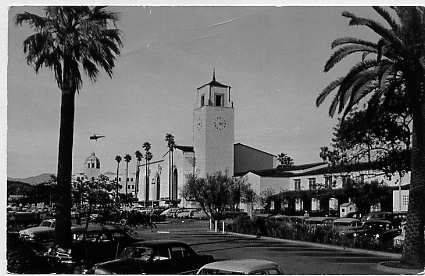
Union Station, Los Angeles
By Beryl Frank

The clock tower shows the Spanish architecture at the Los Angeles Union Passenger Station. Note the helicopter on the left hand side of the picture. The parked cars at the station date to pre-World War II.
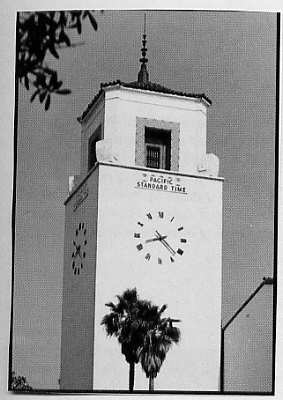
The words 'Pacific Standard Time' were above each of the four clock faces. This was to enable patrons to know what time zone they were in.
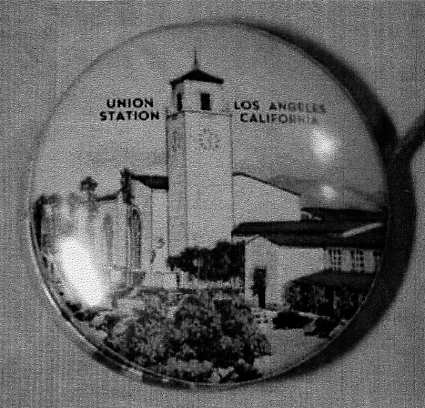
At most union stations there was a gift shop. One of the gifts offered for sale at the one in Los Angeles was an ornamental tape measure showing a view of the clock tower. This was an appropriate gift for a traveler to take home to a sewing friend. Photo courtesy Diane Pelham Burn.
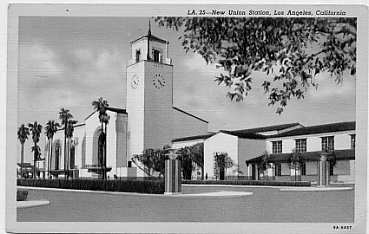
In 1939, the Los Angeles Union Station welcomed travelers from all over the world.
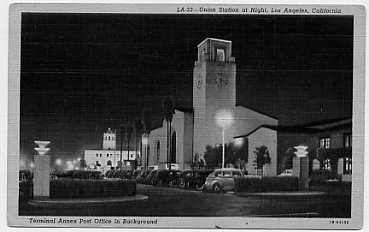
Union Station at night. This postal was sent by a sailor named Bob to his sister in Pennsylvania, and the postage was free as it was to all men in uniform during WWII.
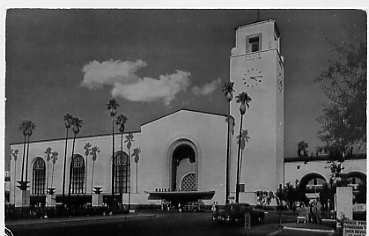
By 1955, the palm trees were taller and postage had gone up to two cents. But Ginger and Bob and Laura still marveled at the train station which many called the entrance to Southern California.
The passenger terminal in Los Angeles, California, was built in 1939. Some people called it the last of its kind to be built in the United States. The exterior merges Spanish Mission, Moorish and Streamlined modern styles.
The station was originally designed to consolidate the passenger terminals of the Southern Pacific; Atchison, Topeka and Santa Fe; and the Union Pacific railroads into one single station. With three different railroad lines, it was definitely a Union station. The architects were H.L. Gilman, J.H. Christie and R.J. Wirth.
After World War II, many central Europeans and displaced Jewish people, freed from Nazi concentration camps, came to Los Angeles. They were greeted not by death but by a new life. They lifted their eyes to the California sky and were welcomed to their new homes.
The terminal waiting room was considered one of the most beautiful in the world. The benches were comfortable and the ceiling was soundproof so the trains called could be heard by the waiting travelers. There were two of these waiting halls described as very elegant, massive and empty.
Early postcards dated 1939 bore one-cent stamps on them with a profile of George Washington. A typical postcard showing the Union Station at night was written by a World War II sailor on his way to San Diego. One fact forgotten by many is that postage for the Armed Forces was FREE. This postcard was so marked and we hope that card reached Reading, Pennsylvania, safely.
Postcard postage had gone up by 1955. The postal now cost two cents a card and President John Adams was pictured. But the station still remained elegant. People waited outside in the California sunshine. Blue skies and white clouds made the waiting time pass quickly.
The end of the twentieth century brought passenger train traffic nearly back to its former glory. Amtrak had taken over the rails. Los Angeles Union Station continues to grow. The Gateway Center opened in 1995. It includes shops, restaurants and offices all located on the Union Station property. In the twenty-first century, Union Station will be a major destination in the proposed high-speed rail system for California.
This Union Station has held its own against airplanes, automobiles, buses and trucks of the 21st century. Trains still run in and out of Union Station, Los Angeles, as they have since 1939.
.